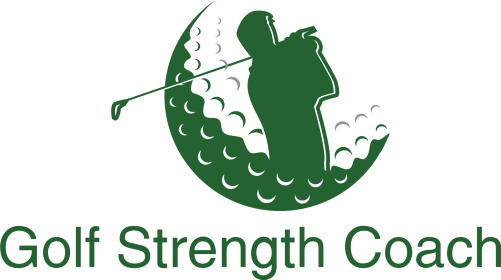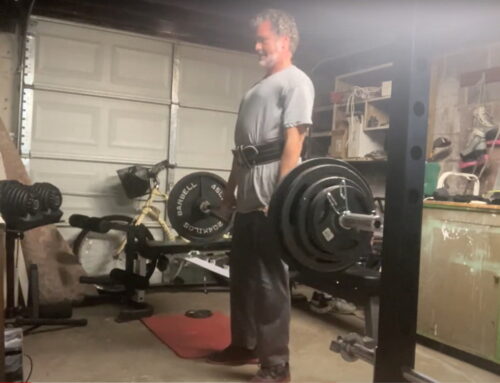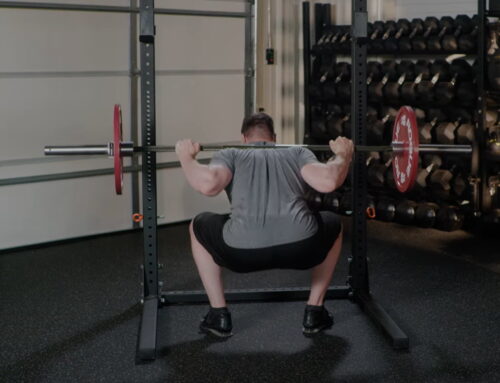
Is this strength training?
Golfers tend to be quite reliable spenders when it comes to trying to lower their scores.
They’ll buy the latest clubs to help them hit longer and straighter shots.
They’ll spend money on golf lessons and buy various gadgets to help them develop a better golf swing.
And, they’ll even spend money to work on their fitness.
As a result of this last idea, the golf fitness industry was born about twenty years ago.
There is no doubt that Tiger Woods had a major impact on the industry as he has packed on more muscle.
Other professional golfers followed suit… Rory McIlroy, Brooks Koepka and Dustin Johnson are well known for spending time in the gym.
Unfortunately, the industry doesn’t seem to have its priorities in order when dealing with the everyday golfer.
Golf Fitness Priorities
In my experience, most golfers are weak and this is particularly true of golfers over the age of 70.
The average age of golfers in the US is reported as 46, while the median age is 54.
Starting at about age 40 (give or take a few years), the process of sarcopenia, or loss of muscle mass begins.
With each passing decade, we lose 3% to 5% our muscle mass, and this process accelerates over time.
Furthermore, some people are susceptible to osteoporosis, or loss of bone density. Osteoporosis is quite prevalent among women post-menopause, but it also affects some men.
If you notice someone in their advanced years who is more than an inch or two shorter than they once were, chances are, they have osteoporosis.
Combined with the lack of muscle mass, this condition leaves them quite weak.
Sadly, Jack Nicklaus appears to be afflicted with condition, as he is about the same height as Gary Player now.
However, the golf fitness industry has an intense focus on mobility, even for senior golfers.
As a result, most golfers are given exercises to help them improve their ability to get more rotation in their golf swings with a variety of stretching exercises and strengthening exercises that target small muscles.
The trouble is, improved mobility is far more difficult to achieve than improved physical strength.
With this in mind, for the vast majority of golfers, strength training should be their number one golf fitness priority.
Golf Fitness Industry Gets It Wrong
However, if you do Google search, or a search on Youtube for strength training for golfers, you’ll be hard pressed to find content where a barbell is used.
What you find instead are numerous exercises performed with dumbbells, kettlebells and resistance bands.
Have a look at that image above. The title of the video from which that image was taken is literally “strength training for golfers.”
That is the kind of stuff you typically see in the golf fitness world.
Yet, the barbell is the single best training tool we have for building strength.
Why is it the case that the barbell is rejected by most golf fitness professionals?
My guess is that there are a couple of reasons.
First, strength training with the barbell eventually gets hard, and they may find that most of their clients don’t want to do hard stuff.
Second, their clients are afraid of getting injured, and the trainer really does not know how to teach the lifts properly.
I know this to be the case, as I’ve seen a top female golfer training in a gym performing a lousy squat. The video was posted by her trainer.
Nobody wants to get injured in the gym.
Therefore, it’s critical that we learn how to perform the movement patterns correctly.
Why the barbell is the best tool for building strength
The barbell is the best tool for building strength because you can load a barbell with significant weight.
Also, the four main barbell movements… the squat, deadlift, bench press and overhead press are based on normal human movement patterns.
These exercises train the most muscle mass, and as a result, when trained properly, you can achieve the most amount of strength over the shortest period of time.
The beauty of strength training with barbells is that you can actually reverse the conditions mentioned above.
Strength training increases muscle mass and improves bone density.
Strength training with these exercises will also help to improve your mobility and balance.
If you can perform a barbell squat with 200 pounds on your back without falling over, you have good enough balance to perform a golf swing.
How fast can you get strong?

Novice Linear Progression
If you are completely untrained, or you haven’t done any strength training for a few years, you can get pretty strong within about four to six months.
This is known as the “Novice” period, where most of the strength gains occur. After that, it becomes more difficult to add strength.
Have a look at the graph that indicates the Novice Linear Progression (NLP).
You’ll notice that your strength increases fastest in the first few months, and then the curve starts to flatten out once you get beyond twelve months from the start of training.
Obviously, defining someone as “strong” is subjective.
If you are an average to median age golfer, even if you’ve never trained, by the end of six months of consistent training, you should be able to
- squat 1.25 x your bodyweight
- deadlift 1.5 x your bodyweight
- bench press your bodyweight
- press 65% of your bodyweight
Quite frankly, these are fairly conservative numbers.
Now, imagine you started out only able to deadlift 50% of your body weight. How do you think this will impact your golf game?
Power = Force x Velocity
Bryson DeChambeau figured this out a few years ago.
In 2019, his average swing speed with the driver was about 119 mph… pretty good.
He then indulged in a strength training and weight gaining program that took his weight up to 240 pounds, and turned himself into one of the longest hitters in the world.
Strength is your ability to produce force.
As we age, we lose the ability to move our body fast. This is why you don’t see any Olympic sprinters past the age of 40.
To help offset that, we can get stronger.
The four main lifts mentioned previously will get you strong from head to toe.
And, if you keep up with your training as you advance in age, you’ll still be able to play golf at a decent level.
Final Thoughts
While you are going through this NLP, by all means, you can work on your flexibility and mobility.
In fact, I include a full stretching and mobility program within my Golf Athlete Training Program.
The stretching and mobility exercises can enhance the benefits you get from increased strength by increasing the range of motion of your golf swing.
The bottom line is that every golfer should prioritize legitimate strength training above all else to improve their potential as a golfer.
After all, the further you can hit a golf ball, the easier the game can be.
Now, get to work!



